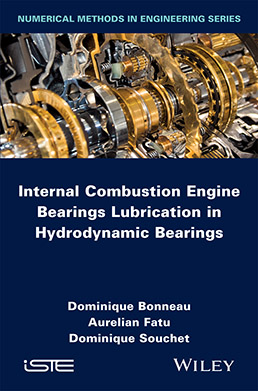
Dominique Bonneau, Institute PPRIME (Laboratory of Mechanics of Solids), University of Poitiers-CNRS-ENSMA, France.
Aurelian Fatu , Institute PPRIME (Laboratory of Mechanics of Solids), University of Poitiers-CNRS-ENSMA, France
Dominique Souchet , Institute PPRIME (Laboratory of Mechanics of Solids), University of Poitiers-CNRS-ENSMA, France
Hydrodynamic bearings allow the various parts of mechanical devices to be driven easily while ensuring a reliability which eliminates any risk of rupture or premature wear. When the operating conditions are severe (high or quickly varying loads, great rotational frequency) it becomes difficult to achieve this double goal without the assistance of powerful prediction digital models.
This 4-volume series of books brings together the elements necessary for the realization and the validation of these tools.
This volume, the last of the series, presents a detailed analysis of specificities of connecting rod big end and small end bearings and of crankshaft main bearings for internal combustion engines and piston compressors: lubricant supply, multi-body connecting rod, bearings with coupled operation, etc. Many examples of application of the digital tools that have been developed from the algorithms presented in previous volumes are illustrated in the various chapters devoted to each of these bearings and it is shown how these digital tools can be used for optimization studies.
These books are of great interest both for researchers wishing to extend their knowledge of the behavior of connecting rod and crankshaft bearings of internal combustion engines and for engineers aiming to develop equipment that reduces engine energy losses while increasing their reliability. The analysis, modeling and solution methods presented here are sufficiently general to be applied to all reciprocating systems, such as, for example, piston compressors.
1. Kinematics and Dynamics of Crank Shaft–Connecting Rod–Piston Linkage.
2. The Crank Shaft–Connecting Rod Link.
3. The Connecting Rod–Piston Link.
4. The Engine Block–Crank Shaft Link.
5. Influence of Input Parameters and Optimization.
Dominique Bonneau is Professor Emeritus specializing in the numerical modelization of lubrication problems who has worked as a teacher-researcher at the IUT of Angoulême and at the Institute PPRIME (Laboratory of Mechanics of Solids) of the University of Poitiers-CNRS-ENSMA in France.
Aurelian Fatu is Professor and a researcher at the Institute PPRIME specializing in the modeling of problems of lubrication for engine bearings and for systems’ sealing devices.
Dominique Souchet specializes in the modeling of thermo-hydrodynamic lubrication of journal and thrust bearings with Newtonian or non-Newtonian fluids. He is a university lecturer and researcher at the Institute PPRIME.